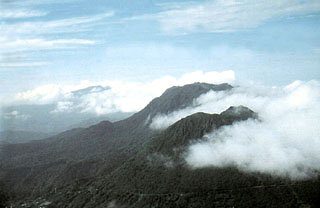Report on Morne Trois Pitons (Dominica) — April 1976
Natural Science Event Bulletin, vol. 1, no. 7 (April 1976)
Managing Editor: David Squires.
Morne Trois Pitons (Dominica) Seismic swarm during February-March
Please cite this report as:
Global Volcanism Program, 1976. Report on Morne Trois Pitons (Dominica) (Squires, D., ed.). Natural Science Event Bulletin, 1:7. Smithsonian Institution. https://doi.org/10.5479/si.GVP.NSEB197604-360100
Morne Trois Pitons
Dominica
15.37°N, 61.33°W; summit elev. 1387 m
All times are local (unless otherwise noted)
On 10 February a local earthquake swarm began on the island of Dominica. Only 12 events were recorded during the next month, but they increased sharply following a regional earthquake (M 5.9) 170 km to the N on 10 March. The largest event of this swarm was 14 March at 2115, but was not recorded on the WWSSN despite a locally estimated intensity of MM VI. On 30 March a 5-station seismograph net was established by a team from the Seismic Research Unit of the University of the West Indies, Trinidad. They have since located over 40 earthquakes with focal depths of generally <3 km. Activity was generally concentrated in a belt extending beneath Roseau, capital of the island, and up to 2 km offshore to the SW.
. . . There has been neither increased steam venting at the nearby Watten Waven Soufrière (inspected on 11 April by John Tomblin, Director of the Seismic Research Unit) nor additional indications of volcanic activity reported elsewhere on the island. Furthermore, earthquake frequency was decreasing toward the end of April and focal depths appeared to be increasing. Similar earthquake swarms in Dominica have been recorded in 1974 and 1971, but they were felt less in the capital city and were therefore less conspicuous. Apart from a minor phreatic explosion in 1880, there has been no historic volcanism on Dominica. Tomblin interprets the recent earthquake as subsurface migration of magma, but feels that the risk of an eruption in the near future is decreasing. The Seismic Research Unit team is continuing to keep a close watch on geophysical activity in Dominica.
Geological Summary. Two large lava-domes complexes, Morne Trois Pitons and Micotrin, rise NE of the capital city of Roseau in central Dominica. Micotrin (Morne Macaque) dome lies immediately south of the larger 1387-m-high Morne Trois Pitons; small lakes are located in the saddle between the two domes and on the eastern flank of Micotrin. The domes are located along the margin of a large semi-circular depression on the western coast of central Dominica, whose origin has been variously attributed to caldera collapse, gravity sliding, or the juxtaposition of several independent volcanic centers. The area is the source of the voluminous, mostly submarine Roseau Tuff, a thick sequence of pyroclastic flows erupted between about 40,000 and 25,000 years ago. It is considered to have originated from calderas at Morne Trois Piton and Wotten Waven, the latter an elliptical NE-SW-trending caldera containing Microtin at its NE end. Explosive eruptions at the Trois Piton-Microtin complex producing pyroclastic flows continued into the late Pleistocene and Holocene. The youngest dated eruption took place about 800 CE, but other smaller eruptions may have occurred since.
Information Contacts: J. Tomblin, UWI; W. Person, NEIS.

